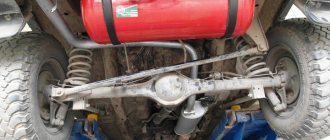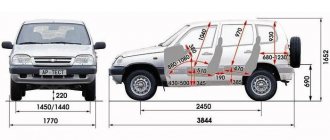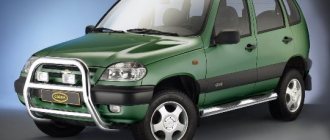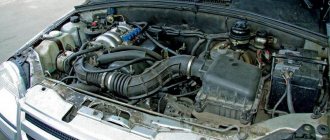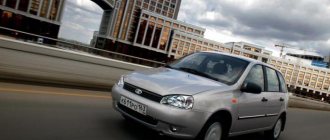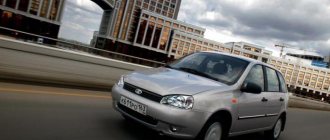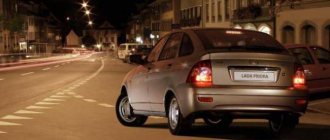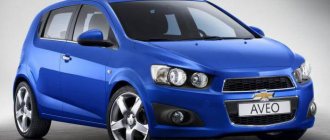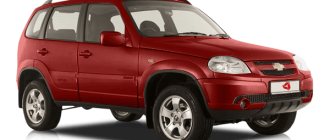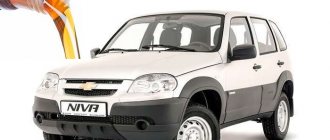Chevrolet Niva is a compact Russian SUV that went into production in 2002, but development of the model began much earlier. The car immediately gained high popularity in the country, and in 2009, a deep modernization of the Chevrolet Niva took place. The car received updated body overhangs, while structurally the model remained the same. In general, the Chevrolet Niva is already a technically outdated car. In 2014, a prototype of the second generation Niva was presented, but the new product has not yet entered production. In this regard, the release of the current Niva has been extended indefinitely.
High gasoline consumption in Chevrolet Niva, possible reasons
The VAZ-2123 engine, which is the basis of Chevrolet Niva cars, was designed back in the 90s. Since then, the ECM on this engine has been updated several times, and a gradual transition from Euro-2 standards to Euro-5 has been made. Oddly enough, with each update, fuel consumption on the Chevrolet Niva increased. You can hear reviews that the 2005 engine consumes 10 liters per hundred, while for later versions the numbers go beyond 14. Well, let's try to understand the details.
The transition to Euro-5 standards is further described in the video. Let's see.
Modifications
Chevrolet Niva (212300 - 55) first rolled off the assembly line back in 2002 and immediately gained popularity among drivers thanks to its good cross-country ability, powerful engine, reliability and low maintenance costs.
In its entire history, the car has experienced only one restyling in 2009 a modern appearance.
Niva Chevrolet 1.7 l
The heart of the Chevy Niva is the VAZ-2123 four-cylinder gasoline engine , developed on the basis of the VAZ-21214 injector back in the 90s of the last century.
Technical characteristics VAZ-2123 engine :
- volume – 1.7 liters
- power – 80 hp
- torque - 127.5 Nm (at 4000 rpm)
- maximum speed – 140 km/h
- acceleration time to 100 km – 19 seconds
The engine was updated and improved several times, was modified and transferred by designers from the Euro-2 environmental standard to modern Euro-5 standards.
Since the end of 2015, all cars have been produced only with a Euro-5 class engine.
Niva Chevrolet 1.8 l
FAM-1 (VAZ-21236) was produced from 2006 to 2008. 1.8- liter Opel Z18XE .
Its technical data was superior to the VAZ engine:
- volume – 1.8 liters
- power – 122 hp
- torque – 167 Nm (at 3800 rpm)
- maximum speed – 165 km/h
- acceleration time to 100 km – 12 sec
The cost of the Chevy Niva in this configuration was much higher, so it was not in great demand, and in less than two years it was withdrawn from the market. However, such fields still travel safely on the roads of the country.
High fuel consumption: reasons Real consumption
| High gasoline consumption in Chevrolet Niva, possible reasons. This is, first of all, high gasoline consumption on average 13-14 liters per 100 km on the highway in the summer. Gasoline consumption is quite high, because according to the passport it is 12 liters in the city, but in reality it is about 13 liters. If you analyze the characteristics of the Niva-Chevrolet car, reviews from owners, the fuel consumption of 14 liters suits drivers, and many do not want a new car. |
| Chevrolet Niva fuel consumption per 100 km: reviews and real As practice shows, the fuel consumption of the Chevrolet Niva has become another reason why consumers from the CIS countries chose this particular model. Mixed mode with off-road crawling, air conditioning on, cold starts and long idling during photography gave 9.5 10 liters 100 km, which is quite economical for a Niva. |
- City – 10.8;
- Highway, 5th gear (90 km/h) – 8.6;
- Highway, 5th gear (120 km/h) – 11.6.
Niva's fuel consumption is acceptable! • They simply don’t work, and the only people who benefit from such purchases are the scammers who actively advertise the miracle shock remedy.
Methods Not Recommended
Dangerous ways to save money include turning off the ignition when driving on long descents. When the engine stops, the vacuum brake booster does not work; it is not possible to stop the car urgently. On descents, it is necessary to use the engine braking mode without moving the gearbox lever to the neutral position (at idle speed the power unit consumes fuel). You should not purchase magnetic devices to save fuel or devices for stabilizing or storing electrical energy that are inserted into the cigarette lighter.
Official expense
The gasoline engine with a displacement of 1.7 liters is “native” to the car. The engine was designed by AvtoVAZ engineers. The power unit develops a power of 80 horsepower with a torque of 128 Nm. The maximum speed of the car is 140 km/h. A 5-speed manual is available as a transmission. The official gasoline consumption of the modification with a 1.7-liter engine is: 13.5 liters in the city and 8.5 liters on the highway.
Gasoline consumption on a Chevrolet Niva increases during dynamic driving. In addition, in winter, an additional amount of fuel is used to warm up the car, and consumption also depends on the condition of the fuel system. In general, owners report the following indicators of the SUV’s “appetite”:
- Evgeniy, Tyumen. When choosing a new car, the main thing for me was that the vehicle was stable on the road and reliable off-road. After two years of operation, I can say with confidence that the Chevrolet Niva copes with its responsibilities perfectly. I am a fisherman myself; I often travel out of town to the nearest fishery. There has never been a time when I got stuck somewhere or skidded, although sometimes we leave in not the best weather for flying. Fuel consumption per 100 km for my car with a 1.7-liter engine is 14 liters in the city in winter, 13 liters in summer, and about 9 liters on the highway.
- Anatoly, Cheboksary. I purchased a Chevrolet Niva in 2011 with a mileage of about 80 thousand km. I took the car for daily use. I like almost everything about the car; there were no significant breakdowns. So, I only changed little things that were recommended by the manufacturer after a certain number of kilometers traveled. And so that I stood somewhere in the middle of a road or field, this has never happened before. The actual fuel consumption of the SUV is 13.8-14 liters in the city, which is slightly more than the rated specifications.
- Leonid, Moscow. I've been driving a Chevrolet Niva 212300-55 for several years now. The most optimal car for native roads. The suspension is reliable, the fit is good, but there are also disadvantages - the 1.7-liter engine clearly lacks power, overtaking is poor, plus poor sound insulation. The car is not bad, but needs improvement; in particular, the problem with gasoline consumption is obvious. Personally, I have the following indicators: 14 liters in the city in the summer and up to 15 liters in the winter, and on the highway it can shoot up to 10 liters.
- Alexey, Rostov. For a long time I read reviews on the Internet regarding the level of gasoline consumption of Shevrik, but I took a chance and purchased our car. What can I say, Niva has its advantages, but it also has its disadvantages. In general, as for a domestic manufacturer, the product turned out to be quite good. But something needs to be done about the “appetite” of the car. According to the passport, 13 liters are stated, but I mostly have 14 liters, or even 14.5 liters. Everything would be fine, but I often stop at gas stations.
- Stanislav, Krasnodar. During the run-in, I also recorded high gasoline consumption figures - 14.5 liters or more. But this was exactly the case until this period ended. Afterwards, the consumption settled down and became more or less acceptable: 12 l/13 l – summer/winter, and on the highway at an average speed of 90-100 km/h the car consumes the rated 8.5 l. Consumption increases in winter, when gasoline is used to warm up, and you can get stuck in traffic jams; in summer, fuel consumption still seems to be normal.
Screen, camera, socket
Generally speaking, Niva came from Togliatti to test the multimedia systems of domestic all-wheel drive vehicles. Yes, yes, it has a color screen and accompanying electronics. You will find a detailed report in the August issue of Za Rulem magazine. But as a person who, due to his age, is inclined to be skeptical about newfangled toys, I will share my impressions.
The main thing is that they didn’t skimp on the screen and rear view camera: everything works fully. But there are also very interesting little things. Multimedia was integrated into the old interior, and the forced decision turned out to be successful. Imagine placing a monitor in the center console. If you place it high, there will be important buttons at the bottom. If you give the top row to the controls, the screen shifted to the gear lever will lose its meaning altogether. In Niva it was placed to the right of the visor of the instrument cluster. It turned out well - both the buttons are in the right place and the screen. The multimedia control unit fits into the single-din hole for the radio. Also successful. Moreover, the system is available not only to owners of new Nivas: the factory workers promise to negotiate with dealers and ensure the installation of multimedia on any Nivas produced after 2015.
The multimedia system screen is successfully integrated into the interior.
The multimedia system screen is successfully integrated into the interior.
Music screen. System features - tracks are displayed in alphabetical order, regardless of the initial division into folders. |
The menu is intuitive. The user will quickly understand all the functions of the system. |
Another one
An important feature is the ability to turn off the screen (but not the system) in one click.
To do this, just click on the large right “twist” on the control unit. Very comfortable at night. Let's say they turned off the screen so as not to distract. You perceive navigation system commands only by ear. I needed a card - I pointed it with my finger, looked and turned it off again.
I was pleased with the system and its intuitive controls. I figured it out on the fly - I was in a hurry to get the test. So, the instructions were never needed. And there was no need to take much attention from the road—peripheral vision was enough to launch certain functions.
The multimedia control unit is located in place of the radio. Its USB connector is live, regardless of the position of the key in the ignition switch. |
The USB connector in the tray between the front seats is de-energized when the ignition is turned off. |
Navigation screen. Navitel is installed here. Works correctly. |
Projection from the rear view camera. Parking is convenient, the towbar does not block the view. |
The rear view camera itself is located in the rear bumper above the license plate. |
And finally, charging gadgets. The question is fundamental. Nowadays there is a fashion to turn off the power to all sockets and USB connectors when the ignition is turned off. Like, I went to the store, you can’t leave your phone in the car. But the Niva is an SUV and is used for long stays in nature. There are no sockets in the forest - you only need to recharge gadgets from a car battery. And it’s much more convenient to do this when the outlet is always powered. That is, it is possible to charge when the car is on the security alarm and the key is in the owner’s pocket. In this regard, Niva was made correctly. The introduction of multimedia did not affect the reasonable power supply of outlets. The one between the front seats is de-energized when the ignition is turned off, and the one on the control unit in the center console is always powered.
Why does Chevy Niva consume more fuel?
Therefore, those comrades who say that the engine dies after 60 thousand, alas, but this is due to improper operation of the engine, you need to warm up the engine, no matter who writes that you can ride on a cold one, REMEMBER, the laws of thermodynamics, MANAGERS will not bypass, physics cannot be deceived. But there is also a second side to the coin; many drivers of such a car more than once speak angrily on car enthusiast forums about this model, and, accordingly, about the cost of gasoline for it.
Kia Soul
My wife has been asking for a long time to exchange the 2010 RAV4 for a new car, but to choose the appropriate option, with her options.
Dealer news:
New cars and used cars - tens of thousands of ads for sale. Reviews from car owners. Technical characteristics and accessories. Comparison of models and Test Drives. News from the world of cars. Prices for new cars. Promotions and special offers from car dealerships. We will help you make your choice!
This site is for informational and reference purposes only and under no circumstances constitutes a public offer.
Certificate of registration of mass media EL No. FS77-68106 dated December 21, 2016. Issued by the Federal Service for Supervision of Communications, Information Technologies and Mass Communications. 16+
Objective difficulties of fuel economy on the Niva-Chevrolet Real numbers
| Reducing fuel consumption on a Chevrolet Niva. I liked the cross-country ability and inexpensive maintenance, the low cost of spare parts, but the dynamic characteristics of the Niva, for that kind of money, leave much to be desired, and the interior is a bit cramped for me. Padzherik was very tired of his senile ailments, which I inherited from previous miracle owners: a rotten frame and bottom, a burst engine head, fuel equipment clogged with shit, a leaking tank, soured calipers, a dead viscous fan coupling, a leaking radiator, rattling glass in the doors. It’s a long wait for spare parts, and the price tags there are in dollars. |
| Chevrolet Niva 1.7 fuel consumption per 100 km I suspect that the new version of the shniva, which was presented not so long ago at the auto show, will cost unreasonable money; this is apparently a general trend and a consequence of the rising dollar. As practice shows, the fuel consumption of the Chevrolet Niva has become another reason why consumers from the CIS countries chose this model. |
Reasons for high fuel consumption • The actual fuel consumption of the VAZ 21213 per 100 km will differ slightly from the declared one.
Main competitors
In its niche and price segment, the Chevrolet Niva is the undisputed leader. When choosing a car that costs 400-800 rubles, car enthusiasts consider, in addition to the Niva, only the Lada and Renault Duster, and sometimes the Japanese Suzuki Grand Vitara. They also look at Chinese and Korean SUVs, but much less often: Ssang Yong Actyon, Chery Tiggo, Great wall H3.
If you choose between Niva Lada or Niva Chevrolet. The choice will fall on the first model only if there are insufficient financial resources. Since the Chevrolet looks more modern and is more comfortable inside, its trim levels have more options, especially in the restyled version.
If you choose between a Chevrolet Niva or Renault Duster, then you should choose the latter if you are not a hunter or fisherman and do not travel through impassable places, and if the level of comfort is more important than the level of cross-country ability.
Chevrolet Niva - consumption according to the passport and real
Most of the reasons why a Chevrolet Niva may experience heat are banal and lie on the surface. But some problems may require professional diagnostics to determine.
Along the highway
In practice, the highway driving mode for the Chevrolet Niva is the most economical driving option. This is also reflected in the passport characteristics declared by the manufacturer for this car.
But it is worth considering that fuel consumption according to the passport will differ from consumption in real conditions. Factory tests create ideal conditions and maintain optimal engine speed and rpm.
The main advantages of the car
The first thing I want to say when looking at the Chevrolet Niva is:
- compactness (does not cause any special problems when parking),
- stability on difficult road sections,
- high cross-country ability (fording is possible, and if you know how to use the transfer case, the Chevrolet Niva will allow you to get out of difficult situations without outside help - from any mud, slush and snowdrifts),
- engine power is enough to climb steep mountains,
- high landing,
- spacious salon,
- The increased heat resistance of the linings on the clutch discs comes in handy during friction and rocking.
Competitive advantages
The main competitive advantage of the Chevrolet Niva is its ability to cope with any negative road conditions. It was possible to achieve high cross-country ability due to a ground clearance of more than 20 cm (varies from 20 to 24 cm), not wide overhangs, and most importantly due to a reliable transmission. Ground clearance can be increased by installing 17-inch wheels rather than 16-inch ones. Cross-country ability and stability on the road in adverse weather conditions will be higher if you purchase wheels with high-profile tires.
Video: Chevrolet Niva GLC Multimedia - is it worth buying in 2019?
LPG consumption
From how easily the steering wheel turns, how high you sit, how powerful the engine sounds, how the car sways on bumps, how respected you are on the road, how clearly the car brakes, how it pulls at the bottom, what a good view in the mirrors. There are also amateurs who engage in 4th gear and drive it at 40 km per hour, excuse me, there is no understanding at all of how the engine works, such a miracle driver can burn out the engine in 30 thousand or even earlier.
Niva - table of fuel costs for different brands. - Specifications
Reducing fuel consumption in new Nivas with injectors is carried out by new firmware of the controller; you are given a new economical program in which the parameters of the Niva fuel system and the ignition system are changed. The fuel consumption of the VAZ 21213 per 100 km is also influenced by the speed at which the car moves, the year of its manufacture and many other factors, from the condition of the road surface, the correct selection of car tires and their wear, to the driving experience of the driver himself.
| Chevrolet Niva Generation 1 (Restyling) | ||||||
| Modification | Average (l/100 km) | Route (l/100 km) | City (l/100 km) | Fuel type | Tank volume (liters) | |
| 1.7 l. i, 80 hp | Manual transmission, AWD | 10.8 | 8.8 | 14.1 | Petrol | 58 |
| 1.8 l. i 16V ECOTEC, 125 HP | Manual transmission, AWD | 10.1 | 8.4 | 12.7 | ||
Niva's fuel consumption depends on the driving cycle. • Real consumption
| We measure the actual consumption. Chevrolet Niva Some owners try to convince other people that their car consumes so little that a little more it will start to produce gasoline or diesel. A good step would be to buy a used car, but this option is suitable for those drivers who understand the car and can see the existing breakdowns themselves. |
- Chevrolet Niva (Generation 1 – 1998-2009; Generation 1 Restyling – 2009-present).
How not to reduce fuel consumption • However, let the owner make the final choice.
How to make car operation even more profitable
The question: “how to reduce gasoline consumption?” - almost every driver is interested. Only by reducing fuel costs can you afford to travel wherever your heart desires, without denying yourself anything.
Basic Rules
There are several tips to help save on fuel:
- do not use faulty machines;
- cars that have at least some breakdowns require more fuel;
- Only thanks to such gasoline consumption, you can spend a couple of liters more than necessary;
- never skimp on the quality of fuel, you will regret this more than once, because low-quality raw materials entering the car disrupt quite a lot of processes, making the car faulty;
- So you immediately ruin the car and increase fuel consumption due to these breakdowns.
In any case, the average gasoline consumption of the Chevrolet Niva will not allow you to spend too much.
Niva Chevrolet 1.7 l
We can conclude that the energy consumed by the Chevrolet Niva transmission exceeds the losses caused by rolling friction in the tires.
This is bad. However, for most light SUVs everything looks exactly the same. Often gas stations try to make money from drivers by filling the tank with low-quality fuel. This entails the following consequences:
- A large amount of impurities or a low octane number of gasoline reduces engine efficiency.
- Paraffin and other contaminants found in low-grade gasoline clog injectors, filters, throttle bodies and fuel pumps.
Therefore, you need to refuel only at proven gas stations. This will help save fuel and extend engine life.
Important: Do not fill in “washing gasoline” - it is safer and more effective to flush the injectors and fuel system with special liquids. True, to do this you will have to disassemble the throttle and remove the injectors.
Various additives that reduce fuel consumption, clean injectors and increase the octane number of gasoline, at best, will not cause harm. At worst, they will clog the jets and leave carbon deposits on the spark plugs.
Owner reviews • Real consumption
| Real fuel consumption on a Chevrolet Niva per 100 km and how to reduce it. Therefore, those comrades who say that the engine dies after 60 thousand, alas, but this is due to improper operation of the engine, you need to warm up the engine, no matter who writes that you can drive on a cold one, REMEMBER, the laws of thermodynamics cannot be circumvented by MANAGERS, physics cannot be deceived. I am glad that the fuel consumption is low and corresponds to the fuel consumption rate declared by the factory for a Chevrolet Niva on the highway: 10.4 liters, for me at a speed of 90-100 km h it reached 8 liters, at 120-130 km h 10.5 liters, in the city 12 -13 comes out. |
| Everything about fuel consumption per 100 km for the Chevrolet Niva | Niva Repair Basically, on the forums it is recommended to calculate consumption per car in such a way as to find out how much its maintenance costs per year, and not per month, as is usually done. Some owners try to convince other people that their car consumes so little that in just a little bit it will start to produce gasoline or diesel. |
- fill with high-quality gasoline;
- keep the car in good technical condition;
- maintain a calm driving style.
Is there an alternative?
To save fuel, some suggest converting to gas. There is a lot of debate on this issue, however, if you agree to such a rework, you should take into account the opinions of critics:
- It is not possible to repair the engine at every service center - for service you will have to visit a specialized workshop;
- gas consumption is higher - compared to gasoline, 1.5 times more fuel is required;
- burnout of the cylinder head gasket - the standard resource of 150 thousand km can be safely divided in half;
- gas takes away power, and Niva already doesn’t have enough of it;
- cross-country ability is reduced - if a gas cylinder is installed behind the rear gearbox, it noticeably reduces ground clearance.
Practice shows that HBO is not the best option for Niva. To increase cross-country ability, some try to place the cylinder in the trunk, but the container will take up its entire volume.
Adding to the complexity is increased engine wear and reduced vehicle performance.
Still, the best option for a Chevrolet Niva is high-quality gasoline and proper care.
